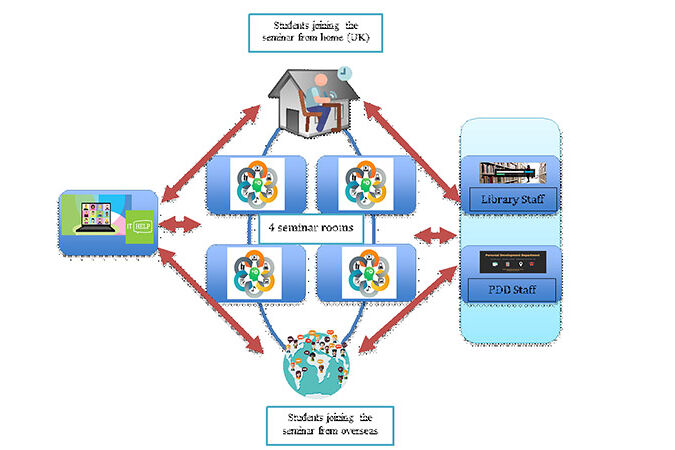The BA Honours Working with Children, Young People and Families course is unique within our department due to it straddling 3 disciplines as noted prior within the faculty. Interdisciplinary practice historically in the UK is also a newly founded approach in Educare and therefore is where my ‘troubling’ (Butler 1992, St Pierre 2000, Lather 1996) is based.
To research
The professional status attached to careers in the field of interdisciplinary practice varies significantly. This pilot enquiry is designed to gain optimal collaboration from students to support course based definitions of professionalism (Joynes 2017). Discussions around interdisciplinary practice are largely based on post qualifying students however our students are pre-qualified so is useful to gauge opinions prior to employment. Pedagogy within our course focuses on the core skills needed to be a ‘professional’ on the course rather than each specific discipline ethos and principals (McDonald 2004). Key aspects of the literature review noted particular focus on vocational ideology and the need to be aware of silo roles in order to work collaborative and for professionals to be collaborative in their behaviour.
Interdisciplinary practices when working with children, young people and families are evident in children centres as the foundation of social regeneration and the previous Every Child Matters Policy (Laming Review 2003) that enshrined interdisciplinary practice in legislation had as its founding principle an action to strengthen communities around children and families in areas of social deprivation. Therefore pedagogic practices should support social justice and be embedded in learning opportunities for students relevant to these children, young people and families and their needs and not focus on the productivity requirements of the institution (Reay 2004). Practitioners within Interdisciplinary practice are a crucial aspect of early intervention and therefore students need to be equipped to support the most vulnerable in society. This pilot enquiry aims to explore these themes from a student perspective linking to their professional identity.
This Degree sits in a ‘new’ University that still advocates rationality of disciplinary habitus instead of a interdisciplinary habitus (Bourdieu 1977) for example module delivery is covered from all three disciplines but these are taught in the discipline silo and no module is collaborated on by all three disciplines therefore the course loses social capital and power due to each field having different doxas that reign (Naidoo 2004). A factor of widening participation for this course is no level field start point therefore to engage in Higher Education and develop professional identity may need individualised opportunities to build their skill and knowledge base instead of whole cohort focus (Ball 2010). Pedagogical approach and knowledge of individualised student profiles has become an important aspect of this research in regards to students’ professional status.
Landscape change sees a need to review and create a ‘new knowledge based’ course in order to support interdisciplinary practice without the generalisation of a ‘professional’. Caipe (2017) agree Interdisciplinary Practice is ‘dealing in difference’ and will need to challenge what it terms as ‘groupthink’, the idea of stereotypical views of disciplines and how to teach and learn within Higher Education. Ball (2018) notes the difficulty as these views are entrenched not just in Higher Education but a mirror of our state as a society and these traditional stereotypes are still prevalent and impact on the hierarchies such as Higher Education institutions and interdisciplinary settings as they are supported by social capital and power (Bourdieu and De Saint Martin 1995).
To practice
Hidden policy conflicts between agencies can create tribalism and revert professionals back to their silos. This is reinforced by Gerwtiz’s (1998) notion of non-distributional social justice where ‘goods’ are not principally distributed in these disciplines via policy impact. The current policy landscape (Children’s Commissioner 2020) can perpetuate deficit discourses such as the focus of a coordinated approach with a relentless focus on addressing social injustice through standardisation, skills and support for the profession but no focus on the education needed for the future professional pre-qualification. Coincidently current standardisation in profession and reflected in teaching and learning goes against the need for individualism in practice and conveys the expectation of conformity which Derbyshire (2017) Suggests is a barrier to professionals’ ability to make decisions/judgements independently and show initiative.
Boundary blurring of disciplines in interdisciplinary practice is also a barrier to interdisciplinary practice (Lewis 2004, Salter 1998) and relative to Foucault’s notion of discipline as knowledge but also application and power of this knowledge (Hall 2005). Working less in silos and more in collaborative roles can either create less or more legitimacy and power. Varying legitimacy and power is discussed in terms of boundary spanning seen in strategy leadership however there is an argument that interdisciplinary professionals boundary span consistently in their role at any level and this should be acknowledged (Baxters brunfit 2008, Williams and Subbould 1999).
To teach
Educators differ in practice backgrounds, theoretical orientation and preferred learning methods therefore consistency in pedagogy for students is not achievable. CAIPE (2017) sees Interdisciplinary practice learning interventions as ad hoc due to changing contexts and suggests such practice can be difficult to knit together into coherent and progressive sequences to teach abstract theoretical concepts.
CAIPE (2017) notes team teaching or buddy systems can help promote interdisciplinary pedagogy and having a inter - professional faculty is key. The BA (Hons) WWCYPF programme is based in a small department within a School that combines two of the three disciplines and health is within a different school but are under the same faculty. Silo discipline module delivery is our current pedagogy and due to this approach the nature of different students’ motivations and career aspirations sees spiky grading profiles in different modules. Barr and Brewer (2012) sees facilitation skills as key when teaching interprofessional practice and relevant to the idea of transformational leadership in order to dynamically engage a diverse group in a shared sense of purpose, fostering a group commitment to act collective for the benefit of all involved. This may be a beneficial approach for our course team.
To conclude
The choice of friendship method was important to gather student views, Sabri (2011) notes this method allows the research experiences of the participants to move away from the homogenic understanding and for my project hopefully away from the monolithic employability/professional ideals we ‘think’ students need or have (Pring 2018, Foucault 1972). The battle to move away from ‘Group think’ mentioned above relates to both researcher and participants in this project (Lyotard 1992).
The students will feel more comfortable and empowered to have an honest and confident conversation. Heron (2019) notes the limitation of sector understanding with conventional qualitative methods into student experiences and views this method as an opportunity to understand better through ‘harder listening’. An understanding of student experiences helps to move away from the homogenic to deconstruct. These conversations generate insights that we cannot know through conventional methods following useful inquiry and guided conservations which ask to reflect, share, probe and question topics related to interdisciplinary practice.
References
- BALL, S.J., 2010. New class inequalities in education: Why education policy may be looking in the wrong place! Education policy, civil society and social class. The International Journal of Sociology and Social Policy, 30(3), pp. 155-166.
- Barr, H & Brewer, Margo. (2012). Barr, H. & Brewer, M. (2012). Interprofessional practice-based education. J. Higgs et al. (Eds.) Practice-Based Education: Perspectives and Strategies, Sense Publishers.
- Gewirtz, 281–300. New York, NY: John Wiley & Sons.
- Bourdieu,P and Passeron, J.C. (1977) Reproduction in society, education and culture, London: Sage.
- Bourdieu,P and de Saint Martin, M. (1995) Academic discourse, Stanford, CA: Stanford University Press.
- Butler, J. (1992). Contingent Foundations: Feminism and the question of ‘postmodernism’. In J. Butler and J.W.Scott (eds.), Feminists theorise the political (pp.3-21). New York: Routledge.
- CAIPE (2002) Interprofessional education – a definition. www.caipe.org
- CAIPE .(2017).Principles of Interprofessional Education www.caipe.org.uk – accessed 8/5/2019
- Foucault, M. 1972. The archaeology of knowledge. London: Routledge.
- HERON, Emma (2019). Friendship as method: reflections on a new approach to understanding student experiences in higher education. Journal of further and higher education.
- Joynes,T (2017). Exploring the professional identity of health and social care staff via experiences of interprofessional education and collaborative practice
- Laming Review (2003) https://www.gov.uk/government/publications/the-victoria-climbie-inquiry-report-of-an-inquiry-by-lord-laming, accessed 21/5/19, 1.05pm
- Lather, P., 2006. Foucauldian scientificity: rethinking the nexus of qualitative research and educational policy analysis. International Journal of Qualitative Studies in Education, 19(6), pp.783-791.
- Law, J. (2003) And if the global were small and non-coherent? Method, complexity and the baroque. Lancaster: Centre for Science Studies, Lancaster University. Accessed May 2006.
- Lyotard, J-F. (1992) Gloss on resistance, in The Postmodern Explained to Children: Correspondence 1982-1985. Trans. J. Pefanis & M. Thomas. London: Turnaround.
- McDonald, R. 2004. Individual identity and organisational control: empowerment and modernisation in a primary care trust. Sociology of Health and Illness. 26(7), pp.925-950.
- Naidoo, R. (2004) ‘Fields and institutional strategy: Bourdieu on the relationship between higher education, inequality and society’, British Journal of Sociology of Education 25: 457–471.
- Pring, R. 2018, "Philosophical debates on curriculum, inequalities and social justice", Oxford Review of Education, vol. 44, no. 1, pp. 6-18.
- Reay *, D., 2004. ‘It's all becoming a habitus’: beyond the habitual use of habitus in educational research. British Journal of Sociology of Education, 25(4), pp.431-444.
- Sabri, D. 2011. “What’s Wrong with ‘The Student Experience’?” Discourse: Studies in the Cultural Politics of Education
- St. Pierre, E.A. (2000). Poststructural feminism in education: An overview. In Qualitative Studies in Education, 2000, 13 (5), 477-515





